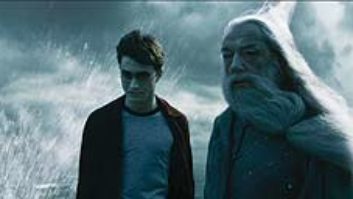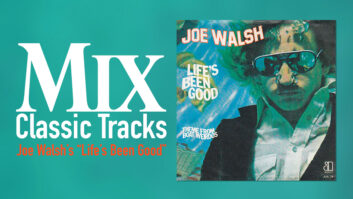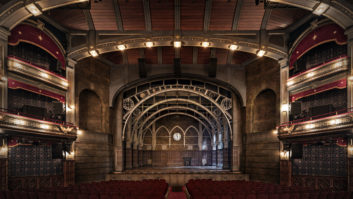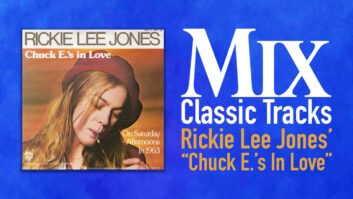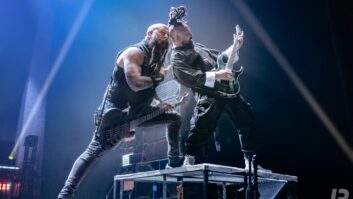Few films in recent years have been as hotly anticipated as Harry Potter and the Sorcerer’s Stone, the first movie to be made from J.K. Rowling’s gazillion-selling children’s fantasy book series. It sometimes seems as though every kid between the ages of 7 and 12 has read one (or all four!) of the Harry Potter books. And truth be told, millions of teenagers and adults have fallen into the series — some parents reading them to their kids (as we did in our household), others just enjoying it for themselves.
It’s hard not to get swept up in this epic adventure, with its strange and memorable characters, magical action sequences and serpentine plot twists that have carried our heroes through thousands of pages of adventures in four separate books, with three more to come in the next decade or so. Why resist? Hop onboard! The Hogwarts Express is leaving platform 9¾ with a trainload of would-be wizards bound for the famous academy that has been training wizards for centuries. The first book — and film — merely lays down the groundwork for a saga that rivals the Ramayana for its sheer scope and wondrous revelations, but what a world we’re plunged into — one populated by killer trolls, headless ghosts, blue-blooded unicorns, living chess pieces, a gargantuan three-headed dog, sinister and peculiar professors…actually, Harry Potter and the other kids at the Hogwarts School of Witchcraft and Wizardry are the most normal entities in the story, even with their magic wands and flying broomsticks (on which they play a fanciful organized sport called Quidditch, high up in the air).
It’s never easy to make a film of a beloved book because, invariably, readers have painted their own mental pictures of the characters, settings and events, and a film necessarily concretizes one interpretation of those elements. To his credit, director Chris Columbus, whose rather light-fare resumé includes such films as Home Alone, Mrs. Doubtfire, Stepmom and Bi-centennial Man, has tried to be as faithful to the books as is technologically possible. He hasn’t Americanized it, thank goodness, or sanitized it. And he chose an exceptional team to help him realize his interpretation of the story. On the visual side, there are such notables as Oscar-winning production designer Stuart Craig (Gandhi, Dangerous Liaisons, The English Patient and The Mission) and director of photography John Seale (The English Patient, Gorillas in the Mist, The Perfect Storm), who, combined with visual effects supervisor Robert Legato and a talented crew of costume and set designers, really make Harry’s world come alive — even the notoriously finicky Ms. Rowling was said to be blown away by how closely they captured her own notion of the book’s look.
On the audio side, there is a big, booming John Williams score and, as you’d expect, lots of creative sound effects; after all, the sound team had to invent the world from scratch from their perspective, too, in coordination with the visual craftspeople. Heading the audio artisans was supervising sound editor Eddy Joseph, whose distinguished career has included work on such films as Lost in Space, Michael Collins, Evita, Interview With a Vampire, Angela’s Ashes, The Crying Game, Enemy at the Gates and many others. (“It seems as though I do most of Alan Parker’s and Neil Jordan’s pictures,” he says.)
We caught up with Joseph at Shepperton Studios in England in late October. He was ensconced in Theatre 4 — with its Harrison MPC console, JBL 4675A speakers and plenty of other gear — still working on Harry Potter, just two weeks from its early November London premiere. “Yes, I’m still on it,” he said with a laugh. “Always a little more to do. You know, there are two versions: In America, it’s Harry Potter and the Sorcerer’s Stone. In Britain, it’s Harry Potter and the Philosopher’s Stone. And it’s also going to be in over 30 languages, as well. So there’s still some work to be done before the beginning of November, getting everything finished and prints made and all.” Still, he graciously took time out of his hectic schedule to talk to Mix about some of the sound aspects of Warner Bros.’ holiday blockbuster.
Were you in on this project from the very beginning?
No, I started at the end of February, and they were about two-thirds of the way through the shoot at that point.
It was shot in England, wasn’t it?
Yes, all the studio sets were at Leavesden Studios, which is where they did Sleepy Hollow and Star Wars: The Phantom Menace. It’s not really a studio. It was the old Rolls Royce airplane engine plant. But there’s plenty of room there, obviously, and it has become a popular place to shoot.
When you came onto the project, did you meet with Chris Columbus to discuss his vision of what the audio for the film should be like? Was there a master plan of what sorts of textures were going to be used?
Not initially, no. I got a call whilst I was completing Enemy at the Gates. They asked if I might be interested, and I had a few things to finish up, but then they called a few days later and offered me the job, so I took it. But at that point, I didn’t get the opportunity to speak to Chris, nor he to me.
How would you define the sound supervisor’s job? It seems to differ from film to film, and person to person.
It does. I like to get my fingers in every pie. I like to think there isn’t much that happens on the sound that I don’t know about. So in that, “supervisor” is correct, but I also like editing. I like to call myself supervising sound editor because the IMDB [Website] likes it. If you start altering your title, it can create problems of identity.
Are you involved with sound effects generation?
Oh, absolutely. I have a sound effects editor named Martin Cantwell, and we talked through everything over the course of two or three months. “Well, what on Earth are we going to do for this?” [Laughs.] So we went and recorded a few easy things like steam trains, and we went to a really old mansion house and recorded a lot of doors and atmospheres and creaks and things. And we also got a few of the kids who are in the film to leap up and down and run along stone steps and wooden corridors, that kind of thing, and to give us a few voices [for backgrounds], which was very helpful. We used a lot of that.
Did you do that field recording on DAT, or what?
Well, we were on HHB Portadat, the new HHB Portadisc system and my old Casio Datman as backup, and that worked out well. This was the first time we used the Portadisc. We were always backing ourselves up and using different microphones in different areas. So everything was recorded three times, it seems, which gave us lots of scope.
One of the interesting things about the Harry Potter story is that it’s modern, yet it has certain medieval trappings. It must have been interesting to try to balance those elements in the sound design.
It was. When Chris Columbus and I discussed the concept, we decided we didn’t want to have anything that sounded electronic or that sounded too modern or futuristic Star Wars-y. It’s a much-hackneyed word these days, but we wanted to keep things “organic,” which we did. It was hard to do, because it’s very easy to take some normal effect and over-treat it so it becomes electronic-sounding.
And do you do that by starting with entirely organic sound sources?
Yes, almost always.
For example, how did you do the Quidditch balls or the Snitch? I would think those could almost have sounded electronic?
Yes, that’s true, but that’s what we were trying to avoid. The Snitch we did partly from wind chimes and a handkerchief speeded up, combined with other things. The Bludger is partly voice. It has to have a sort of an animal entity. Normally, of course, if you have a ball that flies through the air and it narrowly misses people, it would probably have mostly a whooshy sound. Well, that’s not frightening at all, or even humorous, so by adding in the animal element you are aware of it more quickly. So when this thing roars past you — or past them, the players — it has a vocal element to it that is somewhat amusing and also menacing, because it really is dangerous; when it hits people, it can knock them out.
We had a preview in Chicago and the kids there thought what we did was absolutely right, so I guess that one passed the test. We have to set a precedent, I suppose, because there’s Harry Potter 2, 3, 4, up to number 7 being talked about, so we had to lay the groundwork in this one for the effects, and they had to be “right,” if you know what I mean. I suppose they could change them a bit over the other films, but not much.
Were you doing your sound combinations in the HHB system or Pro Tools?
Actually, when Martin was working on his side of it, he was working on an Avid AudioVision, but when he wanted to do interesting things, he’d move it into Pro Tools. Half of my team works on Avid, but will be moving across, unfortunately, to Pro Tools. I say “unfortunately” because the AudioVision is a great track-laying and editing piece of equipment. The Pro Tools is really clever, and you can add in all the software you like, and it works on higher grade and so on. But as a track-laying/editing machine, it isn’t yet as good. I suppose it will be eventually. Over here, particularly, people have been using AudioVisions for a long time; we’ve been involved with it for over six years now and know the machine well.
The other half of the team has been working on the DAR Storm [workstation], which is something I’ve had for years. It is Pro Tools-compatible. What’s great about the Storm is it’s a workstation that was constructed for sound editors, rather than just a computer that was designed for other things mostly, or a mainly musical system — it was built as a sound editor’s workstation. I like that it has a touchscreen, and it’s a genuine 32 tracks you can play with and audition at any time. You can get to and from things very quickly; your directory is there with all the sound effects and reels, and you can move things around without having to open and close bins and move things across, and drag things and everything. It really is instant access. It is great onstage too — it locks quickly and plays backward, as well. The backup is on MO, which is also instant access.
Is it high bit rate?
Yes, you can work on any bit rate you want: 16, 20 or 24. We still work a lot on 16, because if you are taking things from CDs, they’re 16-bit. If you’re a purist and involved in music, I can see the validity for working in 24 and keeping it in 24. But when you think about production dialog and that sort of thing, there’s so much background usually that there’s hardly an occasion where it’s worth being in a high bit rate. Others would argue, no doubt, and will. [Laughs.]
Did they use much production sound on this film?
It was difficult because so much of it is CGI. I mean, you can’t record a three-headed dog, can you?
You mean “Fluffy”?
Right. Fluffy. [Laughs.] I think the Russians managed to make a two-headed dog, didn’t they? But this is a genuine three-headed dog. We had to invent so much for this film — it has a troll, of course, the Devil’s snare [an evil plant], the Chamber of Keys and the game Quidditch.
So I imagine there was a lot of bluescreen work.
Yes, all of Quidditch was done against bluescreen. I think somebody said that there are probably 20 superimpositions in some shots; just layers and layers. You’ve got 14 players in a Quidditch game and each of them have their own moves, so the computer has to deal with that, plus if the three balls are in the shot, there’s another three, plus the backgrounds, plus the crowds. It goes on and on.
Where was the CGI done?
All over the place. Partly ILM, partly Sony, The Mill over here, Cinesite, Smoke and Mirrors, Rhythm and Hues…quite a lot of places.
So, there must have been a fair amount of ADR on this film.
Yes, we did record a lot of ADR. There was quite a bit that needed to be done because of noisy wind machines, especially in the flying sequences, although there’s not a lot of dialog in those sequences. We used as little [ADR] as we could, because if you can use your production track, everyone’s happier. Chris Columbus mentioned that he didn’t like to use ADR unless it was absolutely necessary. He preferred to use the production when we could, and clean it up accordingly.
When you work on a film that has so much CGI, is it difficult from a sound perspective because you have to wait for the visual elements to be completed before you can fine-tune what your sound is going to be?
It is difficult, and there were a number of situations where we were told vaguely what we were going to get, and then the results were rather different.
What’s an example?
Oh, mostly the positions of things. We’d be working to an animation, say, on a flying sequence, and then find that when the next stage comes through, everything’s in a different place and the timing is different; and that can cause havoc. Also, no disrespect to visual effects houses, but they do like to do their own thing — as we do — and you suddenly find that the broom, for example, has got more twigs breaking off than was ever mentioned; or, in fact, it might not have been mentioned at all that the broom had breaking twigs!
So you don’t have the appropriate cracking twigs…
Exactly. Except that we do have it there, because we’re quite clever and we have these things up our sleeve, and we can do them on a moment’s notice. That’s a small example, but there really were a number of occasions where we didn’t get the final shots until…well, a week ago! [Laughs.] We print-mastered half the film, and then we had to wait for the rest of the reels because we didn’t have the shots. But now, it’s all there. We’ve listened to all the sound negs and everything seems fine.
This is a John Williams score?
Yes. It’s a full John Williams score, so I’m sure that you can imagine what that’s like if you’ve seen E.T. or some of his others.
I’ve always thought that the prominence of his scores must make it tougher for sounds to cut through in the mix.
There are times that it gives us a little less room. But it wasn’t really a problem, and there are a number of scenes where the music and the sound effects work really well together. Like in the chess match, he’s given us a sort of military-sounding score, a little like Ravel’s “Bolero.” It’s very effective. It works well on the rolling of the huge chess pieces, which is superb. The art direction and the production design, overall, are just stunning; really exciting. It’s on a very grand scale.
I would think that there would be a number of scenes that would rely heavily on sound: I’m thinking of the third floor hallway with Fluffy, the three-headed monster dog. Then there are all those cavernous rooms…there are so many unique worlds. You have to convey foreboding and then excitement.
You’re absolutely right. There was lots of room for us to try different atmospheres. The acid test is always to listen to the scene without any of the atmospheres, and it just becomes a studio set again. The sound is thick at times. There’s lots of things going, but you know, with all the creative things you need to come up with, you still find yourself going back to the wind squeaking under doors and so on.
Hey, you don’t mess with the classics! Those noises have been scaring people in films for 70 years!
They are the classics and they still work. [Laughs.]
From the sound design perspective, what would you say was the most challenging aspect?
I think trying to actually be true to the story. And that really required a lot of thought. What noise does someone on a flying broomstick make? No one really knows.
So what did you come up with?
Well, you’ll have to hear it, but we think it’s absolutely right for the flying broomsticks. [Laughs.] It’s a combination of a wind-y sound, with flapping of the cloak, a little bit of the twig sound, but you can’t have much. And, not to give too much away, there are a lot of little animal-y noises in there to try to give them a life of their own. A broomstick is only as good as its rider, and in this film it’s like a horse in the end — not that we used any horse noises — but each is different, so we tried to make them a little different. No two are exactly the same.
Did you use sound effects libraries, or were they all generated by your team?
It was almost all generated. I have a lot of libraries, of course, and we often used them in a temp [mix], but we were always saying, “Hang on a second. I’m sure we could do better ourselves.” So we recorded them both in the Foley and then Martin and I did a lot of recording. Every day, Martin would be out there banging bits of wood against the wall, or breaking eggs or whatever he could find on the lot. [Laughs.]
Did the mix pose any special challenge?
It’s very difficult not to make it enormously loud. And it is loud; it has a lot of loud elements.
Yet, there aren’t explosions or gunfire….
No, that’s true. But when you think about it — something like Fluffy has to be pretty noisy. He’s massive, as big as a house, a three-headed dog. When he barks, he’s going to make a lot of noise, and there’s music there as well. If there’s music, people want to hear it. And dialog, too. So all of a sudden, you’ve got a really loud scene.
Is Fluffy one of those modern sound effects designer’s combinations of dog and lion and tornado and wildebeest and whatever?
Actually, he’s mostly dog. In fact, my own dog is in there, as well as the sound of my assistant Richard gnashing his teeth. There are a lot of elements in there.
You asked about the challenge of the mix. Well, the main one is to get all the elements in and give everything a chance and try to always be aware that you are somewhere that no one’s been before. And it’s already in every child’s imagination. I don’t know how many millions of children — and adults — have read this book, but every one of them has a concept of what it looks and sounds like. So we’re hoping to be true to that. But you do have huge problems, like, for instance, owls [wizards use owls to deliver letters and parcels]. If they made as much noise as our owls did, they’d never, ever catch a mouse. [Laughs.] When you hear an owl flying by you, you really hear his wing flaps and more. We have to add in these extra effects because we’re making movies. Our owls are noisy. It was great working with the owls. They’re magnificent creatures.
Does the fact that everyone involved with film production now has one eye on the eventual DVD affect how you do the surround mix for the theater? I suppose there’s automatically a separate DVD mix.
It will be done separately. I believe there will also be extra scenes going into it. Hopefully, we’ll be involved in that, too. I don’t think the DVD mix will be that different. We mixed in EX, as well. We did the SRD [Dolby Digital] with the extra surround. We did all the formats — the SDDS 8-track, the DTS and the SR [Dolby analog].
Were the rears used mainly for atmospheres and broom flyovers, that sort of thing?
Yes, for specific things like that. Brooms flying across, owls flying from back to front. There’s a centaur who leaps front to back. There’s [the main villain] Voldemort — whose name we cannot mention — who does a bit of business in the rears; I shouldn’t go into it… [Laughs.]
There have been an awful lot of movies over the past few years, where you hear something in the surrounds and you look around the room and then you miss the action on the front screen. That’s been a concern of mine.
You mentioned that before this you were working on Enemy at the Gates. From your perspective, is it different working on a heavy war film like that than it is on something so fanciful and lighthearted as Harry Potter? Or is the work the work, no matter the genre?
The work is the work, and the wonderful thing about it is that every film is both exactly the same and totally different. That may sound stupid, but what I mean is that you know you have to go through all the processes, but also every one is a challenge that requires new ways of thinking and of doing things. Enemy at the Gates was a lot of atmospheres and explosions, airplanes — all those sounds of war — but we also went to things of extreme quiet as well. Which is what we did in Harry Potter, too. Movies are movies. They’re entertainment. We had a fabulous time making Enemy at the Gates, as we have had on this. This one has been a long haul and very difficult because of the visual effects and waiting for them. It’s always difficult because until the film is edited, they don’t want to order up all the visual effects, necessarily, because it costs an absolute fortune to redo things. So that slows everything down on our end, and it means we have to do more changes. This final mix was actually the fourth mix. We did a scratch mix, we did a temp, we did a preview and the final.
And you’re still adding and taking out a lot at the fourth mix?
Oh, yes. Up to the last second.
So you bring everything down to the studio with you.
I have everything there. I have my Storm on the stage, and we had an Avid AudioVision, as well. How they work at Shepperton, though, is off Akai DD8. We used it as a backup for storage purposes and whatever else, but also for playing off when we did the predubbing — everything was put onto Akais in the first place, and they were mixed through the desk and predubbed onto other Akais. But we can add in from an Akai or from our own machines.
When we predubbed the flying sequences in Quidditch, before the final shots were in, we used a track-laying system that eliminated the use of complicated panning. This was to use 16 tracks: 1 to 6 for centers, 7 to 9 for left, 10 to 12 for right, 13 and 14 for left surround, and 15 and 16 for right surround. You can, say, put a whoosh or a growly effect on 2 and a sub bass whoosh on 3; crossfade to 7, 8 and 9 for going left, then crossfade to 13 and 14 to continue on left surround. Tracks 4, 5 and 6 would be used for extra effects in the center. It sounds complicated, but if you dedicate 16 tracks on the Harrison, it is very accurate and easy to add in any additional broomsticks that the visual effects houses have unexpectedly given us. All the re-recording mixers have to do is check levels, EQs, etc.
You’ve been working on this for eight months; that seems like a long time.
It is a long time. It was never going to be much less, though. I think we’re about two weeks over the original plan, which is pretty good these days.
Are they talking about the next one already?
Actually, Chris has already shot some of the visual effects for the next one. What they learned is that, particularly in flying sequences, they take a long time to do the composite, and you need to get as much done early instead of the way the first one was done. They begin shooting for real on November 19, which is only three days after the opening in America. I guess the plan is that one will open at the same time every year. It’s like every year is the academic year [as in the book]. I don’t know who will direct the third one, but I guess it will be done in the same way. And if they use the same kids, they’ll be growing up at more or less the right rate.
So does that mean you know what you’re doing for eight months next year?
Well, at this point, it’s being talked about. It’s not final. I’m actually doing Alan Parker’s next film after this. It’s called The Life of David Gale, which is shooting now in Austin, Texas. I’m starting at the end of the year.
And then it’s back to Hogwarts…
I hope so. It’s been a lot of fun.
THE HARRY POTTER SOUND CREW
Eddy Joseph: supervising sound editor
Martin Cantwell: sound effects editor
Colin Ritchie: dialog editor
Nick Lowe: ADR editor
Peter Holt: Foley editor
Richard Fordham, Alex Joseph and Simon Chase: assistant sound editors
Ray Merrin, Graham Daniel: re-recording mixers
John Midgley and Ian Munro: production mixers
